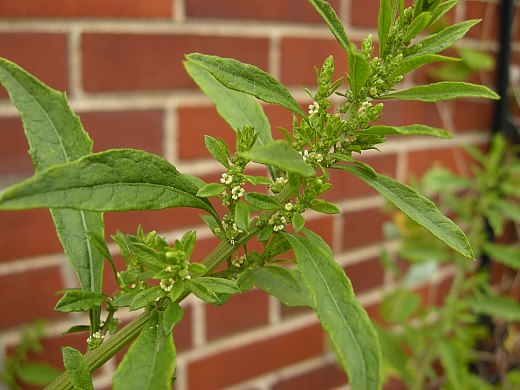Adaptation
As described on the
Habitat page, this plant is considered an invasive species
and can grow under many conditions, therefore there must be some
adaptations that allow Chenopodium ambrosioides to
reside in so many habitats world-wide. In factm, there are a few
things that give this plant a competitive edge.
Being a member of the order Charyophyllales gives this plant a
few unique adaptations. Most Caryophyllales are C4 plants. This
means they utilize a special photosynthetic pathway which allows
them to competitively grow in stressful conditions like saline,
dry, and hot environments. C4 plants grow better because they
photosynthesize faster than C3
plants under high light intensity and high temperatures. They
are able to photosynthesize faster because they utilize an enzyme which allows for quicker uptake
of carbon dioxide and in turn speeds up the entire process of
photosynthesis leading to faster sugar production. C4 plants also
have better water use efficiency since the carbon dioxide is
brought into the plant so quickly that the stomata do not need to be
open as long and therefore the plant loses less water through
evaporation while they are open. This could easily explain why this
plant is able to grow so well in so many places around the
world, especially hot environments with a lot of sun exposure. Just a reminder, photosynthesis is the pathway plants use
to convert light energy to usable sugars for the plant. See
Nutrition for more detail.
C4 plants grow better because they
photosynthesize faster than C3
plants under high light intensity and high temperatures. They
are able to photosynthesize faster because they utilize an enzyme which allows for quicker uptake
of carbon dioxide and in turn speeds up the entire process of
photosynthesis leading to faster sugar production. C4 plants also
have better water use efficiency since the carbon dioxide is
brought into the plant so quickly that the stomata do not need to be
open as long and therefore the plant loses less water through
evaporation while they are open. This could easily explain why this
plant is able to grow so well in so many places around the
world, especially hot environments with a lot of sun exposure. Just a reminder, photosynthesis is the pathway plants use
to convert light energy to usable sugars for the plant. See
Nutrition for more detail.
Another unique quality of the order Caryophyllales is the
presence of red betalain pigments rather
 than anthocyanin which
is the pigment most all other plant species posses. At this
point this seems to just be an unusual characteristic of the
Caryophyllales
order and more research needs to be done into whether or not
these special pigments benefit the plant in any way. Notice the
purplish coloration of the stem in the picture to the right,
this coloring is due to the red betalain pigments.
than anthocyanin which
is the pigment most all other plant species posses. At this
point this seems to just be an unusual characteristic of the
Caryophyllales
order and more research needs to be done into whether or not
these special pigments benefit the plant in any way. Notice the
purplish coloration of the stem in the picture to the right,
this coloring is due to the red betalain pigments.
Next:
Reproduction
Back to
Home